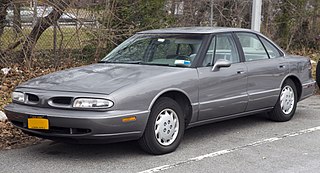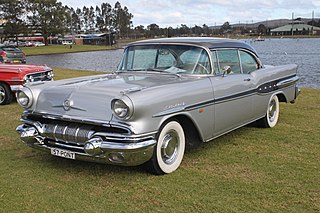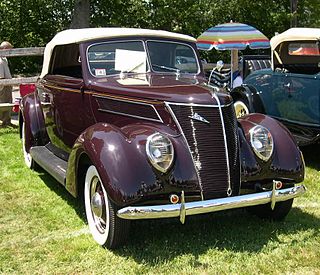
The Chevrolet Chevelle is a mid-sized automobile that was produced by Chevrolet in three generations for the 1964 through 1977 model years. Part of the General Motors (GM) A-body platform, the Chevelle was one of Chevrolet's most successful nameplates. Body styles included coupes, sedans, convertibles, and station wagons. The "Super Sport" versions were produced through the 1973 model year and Lagunas from 1973 through to 1976.

The Chevrolet Bel Air is a full-size car produced by Chevrolet for the 1950–1981 model years. Initially, only the two-door hardtops in the Chevrolet model range were designated with the Bel Air name from 1950 to 1952. With the 1953 model year, the Bel Air name was changed from a designation for a unique body shape to a premium level of trim applied across a number of body styles. The Bel Air continued with various other trim level designations, and it had gone from a mid-level trim car to a budget fleet sedan when U.S. production ceased in 1975. Production continued in Canada, for its home market only, through the 1981 model year.

The Buick Electra is a full-size luxury car manufactured and marketed by Buick from 1959 to 1990, over six generations. Introduced as the replacement for the Roadmaster lines, the Electra served as the flagship Buick sedan line through its entire production and was offered as a two-door sedan, two-door convertible, four-door sedan, and five-door station wagon.

The Oldsmobile 98 is the full-size flagship model of Oldsmobile that was produced from 1940 until 1942, and then from 1946 to 1996. The name – reflecting a "Series 90" fitted with an 8-cylinder engine – first appeared in 1941 and was used again after American consumer automobile production resumed post-World War II. It was, as it would remain, the division's top-of-the-line model, with lesser Oldsmobiles having lower numbers such as the A-body 66 and 68, and the B-body 76 and 78. The Series 60 was retired in 1949, the same year the Oldsmobile 78 was replaced by the 88. The Oldsmobile 76 was retired after 1950. This left the two remaining number-names to carry on into the 1990s as the bread and butter of the full-size Oldsmobile lineup until the Eighty Eight-based Regency replaced the 98 in 1997.

The Oldsmobile 88 is a full-size car that was sold and produced by Oldsmobile from 1949 until 1999. From 1950 until 1974, the 88 was the division's most profitable line, particularly the entry-level models such as the 88 and Dynamic 88. The 88 series was also an image leader for Oldsmobile, particularly in the early years (1949–51), when it was one of the best-performing automobiles, thanks to its relatively small size, light weight, and advanced overhead-valve high-compression V8 engine. This engine, originally designed for the larger C-bodied and more luxurious 98 series, also replaced the straight-8 on the smaller B-bodied 78. With the large, high performance V8, the Oldsmobile 88 is considered by some to be the first muscle car, although this title is disputed.

The Pontiac Catalina is a full-size automobile produced by Pontiac from 1950 to 1981. Initially, the name was a trim line on hardtop body styles, first appearing in the 1950 Chieftain Eight and DeLuxe Eight lines. In 1959, it became a separate model as the "entry-level" full-size Pontiac.

The Pontiac Bonneville is a model line of full-size or mid-size front-engine rear drive cars manufactured and marketed by Pontiac from 1957 until 2005, with a hiatus for model years 1982-1986.

The Series 60 "Special" is a full-size car made by Oldsmobile from the 1939 through the 1948 model years. It was their entry-level model using the GM "A" body platform, giving Oldsmobile an entry-level product with more standard features that would be optional on Chevrolet and Pontiac vehicles using the same platform. Initially, the engine size used was the company's flat head 6 cylinder, while senior models would use the flat head 8 cylinder. For marketing purposes, the Oldsmobile Series 60, or the Oldsmobile 66, took advantage of the national highway U.S. Route 66 established in 1926. It was with this generation that all GM vehicles experienced increased width dimensions to accommodate three passengers on the front bench seat and an additional three passengers on rear bench seat installed vehicles. This was accomplished with the deletion of running board thereby adding additional room inside the passenger compartment and upgrading the floor mounted gearshift to a steering column installed transmission gear selector for the Hydramatic automatic transmission.

Buick Estate is a nameplate that was used by the Buick division of General Motors, denoting its luxury full-size station wagon from 1940 to 1964 and from 1970 to 1996. The Estate nameplate was derived from the term country estate in wealthy suburban areas and estate car, the British term for a station wagon.

The Buick Roadmaster is an automobile built by Buick from 1936 until 1942, from 1946 until 1958, and then again from 1991 until 1996. Roadmasters produced between 1936 and 1958 were built on Buick's longest non-limousine wheelbase and shared their basic structure with the entry-level Cadillac Series 65, the Buick Limited, and after 1940, the Oldsmobile 98. Between 1946 and 1957, the Roadmaster served as Buick's flagship.

The Cadillac Series 40-62 is a series of cars which was produced by Cadillac from 1940 through 1964. Originally designed to complement the entry level Series 61, it became the Cadillac Series 6200 in 1959, and remained that until it was renamed to Cadillac Calais for the 1965 model year. The Series 62 was also marketed as the Sixty-Two and the Series Sixty-Two. The Series 62 was used to introduce the Cadillac Coupe de Ville and the Cadillac Eldorado which started out as special appearance packages that were later placed into production.

The Cadillac Series 61 was Cadillac's mainstream product model range. It was priced and equipped more modestly below the limousine, GM D platform Cadillac Series 85, Cadillac Series 90, Cadillac Series 72, Cadillac Series 67, and Cadillac Fleetwood Series 75. It was upgraded to the Series 62 in 1940 only to return to production in model year 1941, replacing the cancelled LaSalle Series 50. While production was suspended from model years 1943–1945 due to World War II, it remained as the junior level product line until 1951. The size, equipment list and quality level were the most popular with buyers who wanted a prestigious luxury car that was usually driven by the owner, while the longer cars were chauffeur driven. It combined the most popular features of the previous Series 60 and Series 65 and was priced at the same level as Buick products of the time.

The Pontiac Star Chief is an automobile model that was manufactured by Pontiac between 1954 and 1966. It was Pontiac's top trim package on the Pontiac Chieftain, with later generations built on longer wheelbases, and serving as the foundation platform for the Pontiac Bonneville. The car was easily identified by three and four star-like trim features along varying areas of the car, a feature all Star Chiefs were equipped with star arrangements as follows in generation discussions.

The Pontiac Chieftain is an automobile which was produced by Pontiac from 1949 to 1958. The 1949 Chieftain and Streamliner models were the first all new car designs to come from Pontiac in the post World War II years. Previous cars had been 1942 models with minor revisions.

Chevrolet Nomad is a nameplate used by Chevrolet in North America from the 1950s to the 1970s, applied largely to station wagons. Three different Nomads were produced as a distinct model line, with Chevrolet subsequently using the name as a trim package.

The Ford line of cars was updated in 1937 with one major change — the introduction of an entry-level 136 cu in (2.23 L) V8 in addition to the popular 221 cu in (3.62 L) flathead V8. The model was a refresh of its predecessor, the Model 48 and was the company's main product. It was redesigned more thoroughly in 1941. At the start of production, it cost US$850. The Ford Line bore several model numbers during this period, each related to their respective HP numbers. In 1937, 85 HP cars were known as Model 78 while 60 HP cars were known as Model 74. This changed to Model 81A and 82A respectively in 1938, and Models 91A and 92A in 1939.

The Buick Super is a full-sized automobile produced by Buick from 1940 through the 1958 model years, with a brief hiatus from 1943 through 1945. The first generation shared the longer wheelbase with the top level Roadmaster while offering the smaller displacement engine from the Buick Special. The Super prioritized passenger comfort over engine performance. For several years, it was called the "Buick Eight" or "Super Eight" due to the engravement on the grille while all Buick's since 1931 were all installed with the Buick Straight-8 engine with varying engine displacement.

The Cadillac DeVille is a model name used by Cadillac over eight generations, originally to designate a trim level of the 1949 Cadillac Series 62 and later for a standalone model in the brand range. The last model marketed specifically as a DeVille was the 2005 full-size sedan, at the time, Cadillac's largest model.

The Pontiac Torpedo was a full-sized car produced by Pontiac from the 1940 through the 1948 model year. When released, it was the biggest Pontiac, used an 8-cylinder engine, and it had more standard features than other Pontiacs. Although the Torpedo name was exclusive to the highest line of Pontiacs in 1940, in 1941 the name was applied to all Pontiacs in three separate lines. The Custom Torpedoes were now top-of-the-line name, while the DeLuxe Torpedo became the base line, and the Streamline Torpedo became the middle line of Pontiacs. All Torpedo models could be had with either a 6-cylinder or 8-cylinder engine beginning in 1941. From 1942 to 1948 the Torpedo name designated only the base line of Pontiacs. The Torpedo was replaced by the Pontiac Chieftain in 1949. It was with this generation that all GM vehicles experienced increased width dimensions to accommodate three passengers on the front bench seat and an additional three passengers on rear bench seat installed vehicles. This was accomplished with the deletion of running board thereby adding additional room inside the passenger compartment.

The Pontiac 6 was a more affordable version of its predecessor Oakland Six that was introduced in 1926, sold through Oakland Dealerships. Pontiac was the first of General Motors companion make program where brands were introduced to fill in pricing gaps that had developed between Cadillac, Buick, Oldsmobile, Oakland and Chevrolet. The original marketing approach began when GM was incorporated in 1908 was to offer a range of vehicles in various body styles based on affordable to extravagant, and the customer base would gradually trade up every few years to the next hierarchy brand. Pontiac was introduced as an affordable Oakland, followed by LaSalle for Cadillac, Marquette for Buick and Viking for Oldsmobile. Pontiac's introduction was a sales success while customers shied away from the more expensive Oakland, and once the Wall Street crash of 1929 and the Great Depression followed, both Pontiac and Oakland were being considered for cancellation but the decision was made to keep Pontiac as the economy began to recover.


































